Using Green, Economical, Efficient Two-Dimensional (2D) Talc Nanosheets as Lubricant Additives under Harsh Conditions
Abstract
:1. Introduction
2. Experimental
2.1. Raw Materials and Instruments
2.2. Preparation of Grease
3. Results and Discussion
3.1. Characterization of Talc
3.2. Lubrication Performance
3.3. Anti-Wear Performance
4. Conclusions
- (1)
- The silane coupling agent was successfully coupled with the talc nanosheets via ball milling. The modified talc nanosheet has a non-defected crystal structure with a thickness and size of about 20 nm and 2 µm.
- (2)
- The modified talc has a much better lubrication performance than the non-modified talc and base grease. The optimum addition level of modified talc is 0.5 wt.%. The modified talc can greatly enhance the lubrication performance under high temperature and high load. Compared with the base grease, the coefficient of friction and wear depth can be reduced by 40% and 66% at high temperature (150 °C) and high load (3.5 GPa), respectively.
- (3)
- The modified talc nanosheets via ball milling together with grafting of the agent can be uniformly dispersed in viscous grease, which has a good chance to make the nanosheets enter the wear interface quickly and form a protective adsorbed tribofilm. This study provides a green and economical way for using nanomaterial as an efficient lubricant additive and has great potential for application.
Author Contributions
Funding
Institutional Review Board Statement
Informed Consent Statement
Data Availability Statement
Conflicts of Interest
References
- Makowski, L.; Bojarska, Z.; Rozen, A. Rheological Properties of Engine Oil with Nano-Additives Based on MoS2 Materials. Nanomaterials 2022, 12, 581. [Google Scholar] [CrossRef] [PubMed]
- Chen, Y.; Hu, E.; Zhong, H.; Wang, J.; Subedi, A.; Hu, K.; Hu, X. Characterization and Tribological Performances of Graphene and Fluorinated Graphene Particles in PAO. Nanomaterials 2021, 11, 2126. [Google Scholar] [CrossRef] [PubMed]
- Zhao, J.; Li, Y.; He, Y.; Luo, J. In Situ Green Synthesis of the New Sandwichlike Nanostructure of Mn3O4/Graphene as Lubricant Additives. ACS Appl. Mater. Interfaces 2019, 11, 36931–36938. [Google Scholar] [CrossRef] [PubMed]
- Kong, N.; Zhang, J.; Zhang, J.; Li, H.; Wei, B.; Li, D.; Zhu, H. Chemical- and Mechanical-Induced Lubrication Mechanisms during Hot Rolling of Titanium Alloys Using a Mixed Graphene-Incorporating Lubricant. J. Nanomater. 2020, 10, 665. [Google Scholar] [CrossRef] [PubMed] [Green Version]
- Li, R.; Yang, X.; Zhao, J.; Yue, C.; Wang, Y.; Li, J.; Meyer, E.; Zhang, J.; Shi, Y. Operando Formation of Van der Waals Heterostructures for Achieving Macroscale Superlubricity on Engineering Rough and Worn Surfaces. Adv. Funct. Mater. 2022, 32, 2111365. [Google Scholar] [CrossRef]
- Nieto, A. The Promise of 2D Nanolaminated Materials as Protective Solid-State Lubricants. Lubricants 2020, 8, 6. [Google Scholar] [CrossRef] [Green Version]
- Duong Duc, L.; Tuan Ngoc, T.; Pham, T.Q.; Hoang Tung, V.; Nam, T.T.; Tuan Anh, N.; Nadda, A.K.; Thanh Tung, N.; Chang, S.W.; Chung, W.J.; et al. Scalable Fabrication of Modified Graphene Nanoplatelets as an Effective Additive for Engine Lubricant Oil. Nanomaterials 2020, 10, 877. [Google Scholar]
- Zhao, J.; Wang, D.; Zhang, F.; Liu, Y.; Chen, B.; Wang, Z.L.; Pan, J.; Larsson, R.; Shi, Y. Real-Time and Online Lubricating Oil Condition Monitoring Enabled by Triboelectric Nanogenerator. ACS Nano 2021, 15, 11869–11879. [Google Scholar] [CrossRef]
- Li, J.; Cao, W.; Li, J.; Ma, M. Fluorination to enhance superlubricity performance between self-assembled monolayer and graphite in water. J. Colloid Interface Sci. 2021, 596, 44–53. [Google Scholar] [CrossRef]
- Wu, J.; Luo, Y.; Chen, Y.; Lu, X.; Feng, X.; Bao, N.; Shi, Y. Poly(ionic liquid)s as lubricant additives with insight into adsorption-lubrication relationship. Tribol. Int. 2022, 165, 107278. [Google Scholar] [CrossRef]
- Gao, T.; Li, J.; Yi, S.; Luo, J. Potential-Dependent Friction on a Graphitic Surface in Ionic Solution. J. Phys. Chem. C 2020, 124, 23745–23751. [Google Scholar] [CrossRef]
- Jin, B.; Chen, G.; Zhao, J.; He, Y.; Huang, Y.; Luo, J. Improvement of the lubrication properties of grease with Mn3O4/graphene (Mn3O4#G) nanocomposite additive. Friction 2021, 9, 1361–1377. [Google Scholar]
- Jin, B.; Zhao, J.; Chen, G.; He, Y.; Huang, Y.; Luo, J. In situ synthesis of Mn3O4/graphene nanocomposite and its application as a lubrication additive at high temperatures. Appl. Surf. Sci. 2021, 546, 149019. [Google Scholar] [CrossRef]
- Zhao, J.; Huang, Y.; He, Y.; Shi, Y. Nanolubricant additives: A review. Friction 2021, 9, 891–917. [Google Scholar] [CrossRef]
- Guo, Z.; Zhang, Y.; Wang, J.; Gao, C.; Zhang, S.; Zhang, P.; Zhang, Z. Interactions of Cu nanoparticles with conventional lubricant additives on tribological performance and some physicochemical properties of an ester base oil. Tribol. Int. 2020, 141, 105941. [Google Scholar] [CrossRef]
- Meng, Y.; Sun, J.; Wu, P.; Dong, C.; Yan, X. The Role of Nano-TiO2 Lubricating Fluid on the Hot Rolled Surface and Metallographic Structure of SS41 Steel. Nanomaterials 2018, 8, 111. [Google Scholar] [CrossRef] [Green Version]
- Zhou, G.; Zhu, Y.; Wang, X.; Xia, M.; Zhang, Y.; Ding, H. Sliding tribological properties of 0.45% carbon steel lubricated with Fe3O4 magnetic nano-particle additives in base oil. Wear 2013, 301, 753–757. [Google Scholar] [CrossRef]
- Zhao, J.; Gao, T.; Li, Y.; He, Y.; Shi, Y. Two-dimensional (2D) graphene nanosheets as advanced lubricant additives: A critical review and prospect. Mater. Today Commun. 2021, 29, 102755. [Google Scholar] [CrossRef]
- Tang, G.; Su, F.; Xu, X.; Chu, P.K. 2D black phosphorus dotted with silver nanoparticles: An excellent lubricant additive for tribological applications. Chem. Eng. J. 2020, 392, 123631. [Google Scholar] [CrossRef]
- Mao, J.; Chen, G.; Zhao, J.; He, Y.; Luo, J. An investigation on the tribological behaviors of steel/copper and steel/steel friction pairs via lubrication with a graphene additive. Friction 2021, 9, 228–238. [Google Scholar] [CrossRef] [Green Version]
- Guo, Y.; Zhou, X.; Lee, K.; Yoon, H.C.; Xu, Q.; Wang, D. Recent development in friction of 2D materials: From mechanisms to applications. Nanotechnology 2021, 32, 312002. [Google Scholar] [CrossRef] [PubMed]
- Park, J.Y.; Kwon, S.; Kim, J.H. Nanomechanical and Charge Transport Properties of Two-Dimensional Atomic Sheets. Adv. Mater Interfaces 2014, 1, 1300089. [Google Scholar] [CrossRef]
- Zhang, S.; Ma, T.; Erdemir, A.; Li, Q. Tribology of two-dimensional materials: From mechanisms to modulating strategies. Mater. Today 2019, 26, 67–86. [Google Scholar] [CrossRef]
- Zhao, J.; He, Y.; Wang, Y.; Wang, W.; Yan, L.; Luo, J. An investigation on the tribological properties of multilayer graphene and MoS2 nanosheets as additives used in hydraulic applications. Tribol. Int. 2016, 97, 14–20. [Google Scholar] [CrossRef]
- Rapoport, L.; Fleischer, N.; Tenne, R. Fullerene-like WS2 nanoparticles: Superior lubricants for harsh conditions. Adv. Mater. 2003, 15, 651–655. [Google Scholar] [CrossRef]
- Zhao, J.; Mao, J.; Li, Y.; He, Y.; Luo, J. Friction-induced nano-structural evolution of graphene as a lubrication additive. Appl. Surf. Sci. 2018, 434, 21–27. [Google Scholar] [CrossRef]
- Spikes, H. Low- and zero-sulphated ash, phosphorus and sulphur anti-wear additives for engine oils. Lubr. Sci. 2008, 20, 103–136. [Google Scholar] [CrossRef]
- Hua, J.; Bjorling, M.; Larsson, R.; Shi, Y. Controlling friction in Ionic Liquid/Glycerol Aqueous Solution lubricated contacts by adjusting CO2 and water content. Tribol. Int. 2021, 161, 107070. [Google Scholar] [CrossRef]
- Bagi, S.; Bowker, R.; Andrew, R. Understanding Chemical Composition and Phase Transitions of Ash from Field Returned DPF Units and Their Correlation with Filter Operating Conditions. SAE Int. J. Fuels Lubr. 2016, 9, 239–259. [Google Scholar] [CrossRef]
- Rastogi, R.B.; Maurya, J.L.; Jaiswal, V. Rastogi, R.B.; Maurya, J.L.; Jaiswal, V. Zero SAPs and Ash Free Antiwear Additives: Schiff Bases of Salicylaldehyde with 1,2-Phenylenediamine,1,4-Phenylenediamine, and 4,4-Diaminodiphenylenemethane and Their Synergistic Interactions with Borate Ester. Tribol. Trans. 2013, 56, 592–606. [Google Scholar] [CrossRef]
- Kumar, N.; Saini, V.; Bijwe, J. Exploration of Talc nanoparticles to enhance the performance of Lithium grease. Tribol. Int. 2021, 162, 107107. [Google Scholar] [CrossRef]
- Saini, V.; Bijwe, J.; Seth, S.; Ramakumar, S.S.V. Potential exploration of nano-talc particles for enhancing the anti-wear and extreme pressure performance of oil. Tribol. Int. 2020, 151, 106452. [Google Scholar] [CrossRef]
- Eguchi, M.; Nugraha, A.S.; Rowan, A.E.; Shapter, J.; Yamauchi, Y. Adsorchromism: Molecular Nanoarchitectonics at 2D Nanosheets-Old Chemistry for Advanced Chromism. Adv. Sci. 2021, 8, 2100539. [Google Scholar] [CrossRef] [PubMed]
- Dokmai, V.; Sinthiptharakoon, K.; Phuthong, W.; Pavarajarn, V. Anisotropic robustness of talc particles after surface modifications probed by atomic force microscopy force spectroscopy. Particuology 2021, 58, 308–315. [Google Scholar] [CrossRef]
- Niu, H.; Zhao, W.; Lv, H.; Yang, Y.; Cai, Y. Accurate design of hollow/tubular porous g-C3N4 from melamine-cyanuric acid supramolecular prepared with mechanochemical method. Chem. Eng. J. 2021, 411, 128400. [Google Scholar] [CrossRef]
- He, X.; Deng, Y.; Zhang, Y.; He, Q.; Xiao, D.; Peng, M.; Zhao, Y.; Zhang, H.; Luo, R.; Gan, T.; et al. Mechanochemical Kilogram-Scale Synthesis of Noble Metal Single-Atom Catalysts. Cell Rep. Phys. Sci. 2020, 1, 100004. [Google Scholar] [CrossRef]
- Szczesniak, B.; Borysiuk, S.; Choma, J.; Jaroniec, M. Mechanochemical synthesis of highly porous materials. Mater Horiz. 2020, 7, 1457–1473. [Google Scholar] [CrossRef]
- Sun, Z.; Duan, X.; Srinivasakannan, C.; Liang, J. Preparation of magnesium silicate/carbon composite for adsorption of rhodamine B. RSC Adv. 2018, 8, 7873–7882. [Google Scholar] [CrossRef] [PubMed] [Green Version]
- Nigam, A.; Saini, S.; Rai, A.K.; Pawar, S.J. Structural, optical, cytotoxicity, and antimicrobial properties of MgO, ZnO and MgO/ZnO nanocomposite for biomedical applications. Ceram. Int. 2021, 47, 19515–19525. [Google Scholar] [CrossRef]
- Fei, J.; Qi, Y.; Luo, L.; Gu, Y.; Huang, J. Synergistic effect of talc/carbon spheres composite as oil-based additive enhancing the lubricating properties for steel-steel contact. Lubr. Sci. 2020, 32, 80–89. [Google Scholar] [CrossRef]
- Pielesz, A.; Binias, D.; Machnicka, A.; Bobinsk, R.; Laane, H.-M.; Tjon, J.; Ulman-Wlodarz, I.; Waksmanska, W. Stabilized Ortho-Silicic Acid as a Modifier of Tissue-Preliminary Comparative Biomaterial Studies. J. Biomed. Nanotechnol. 2020, 16, 538–547. [Google Scholar] [CrossRef] [PubMed]
- Jin, B.; Zhao, J.; He, Y.; Chen, G.; Li, Y.; Zhang, C.; Luo, J. High-quality ultra-flat reduced graphene oxide nanosheets with super-robust lubrication performances. Chem. Eng. J. 2022, 438, 135620. [Google Scholar] [CrossRef]
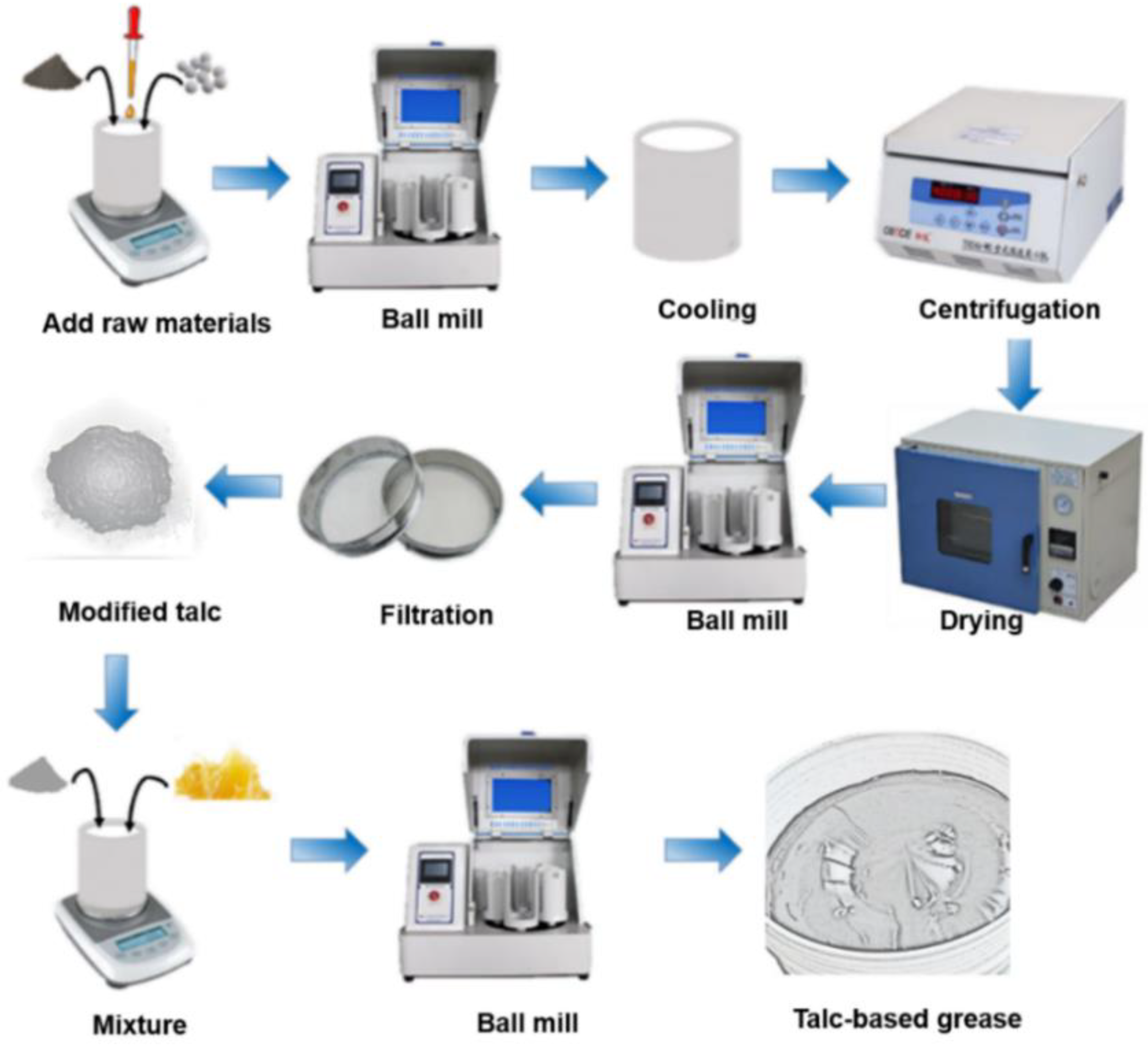

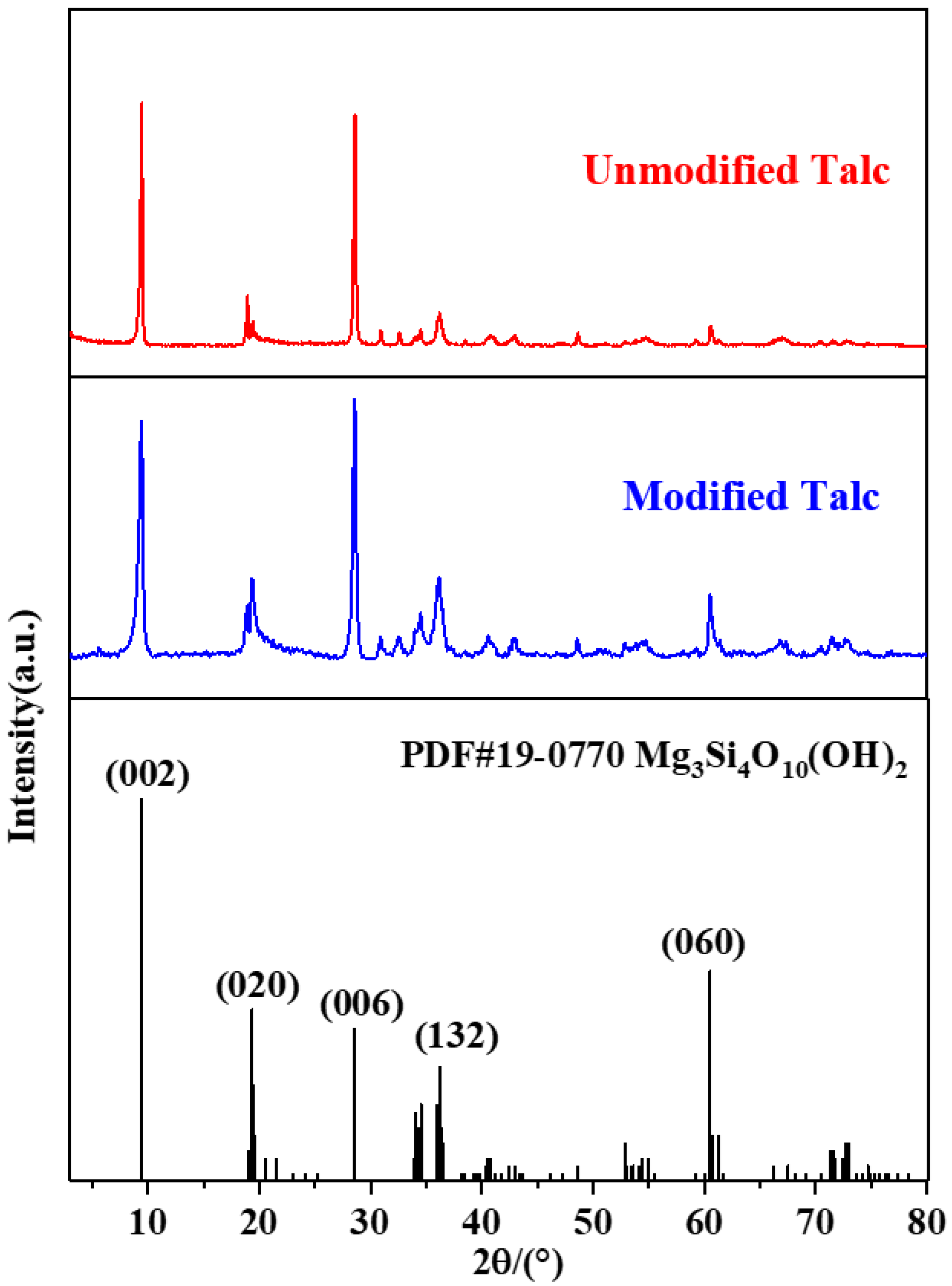
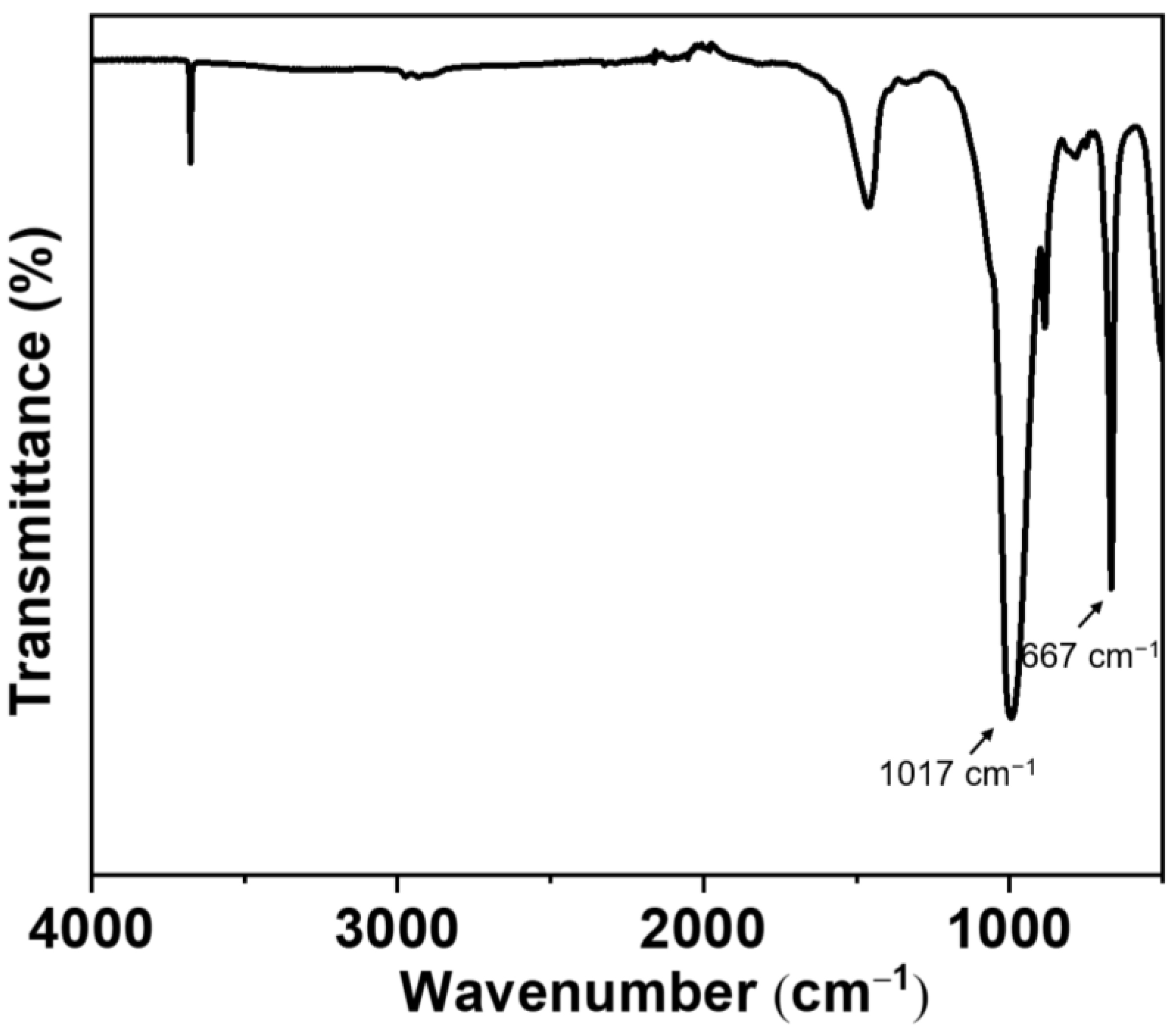
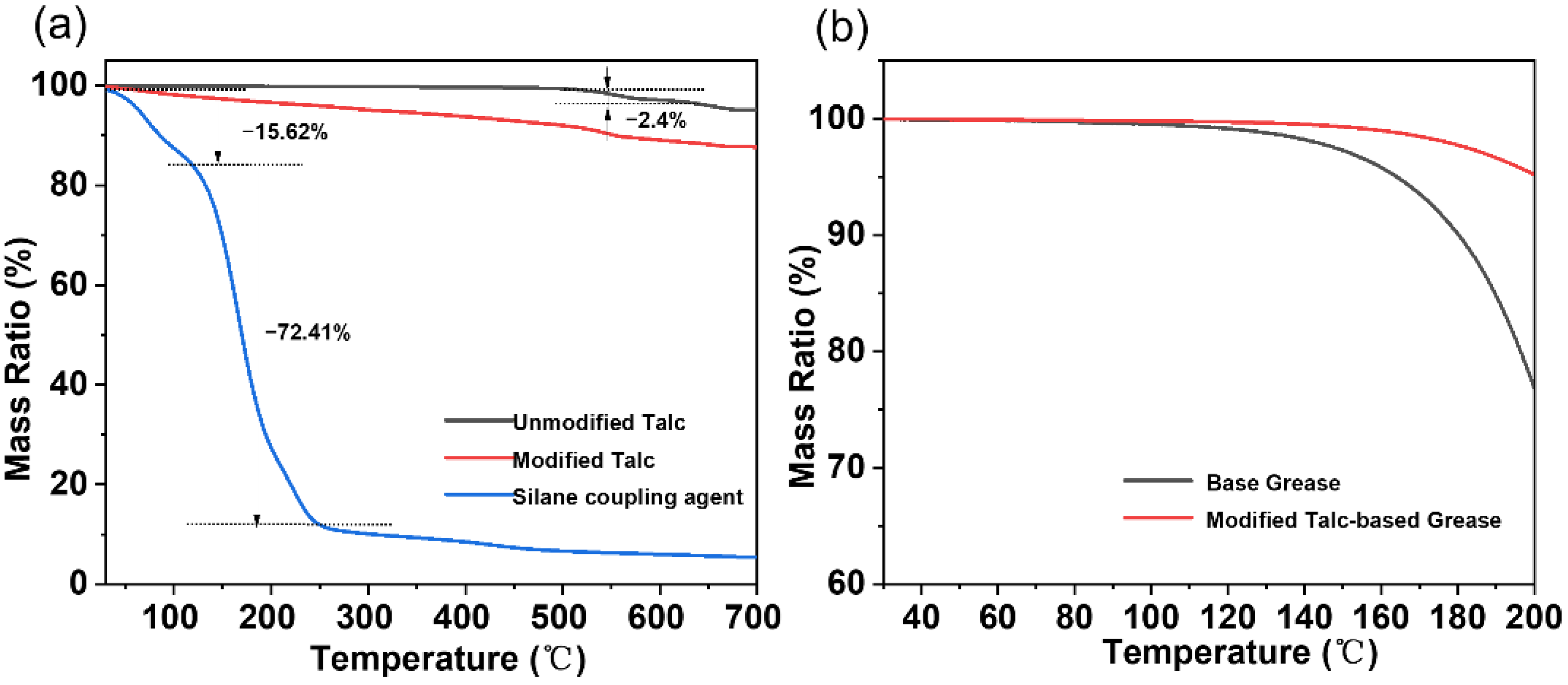
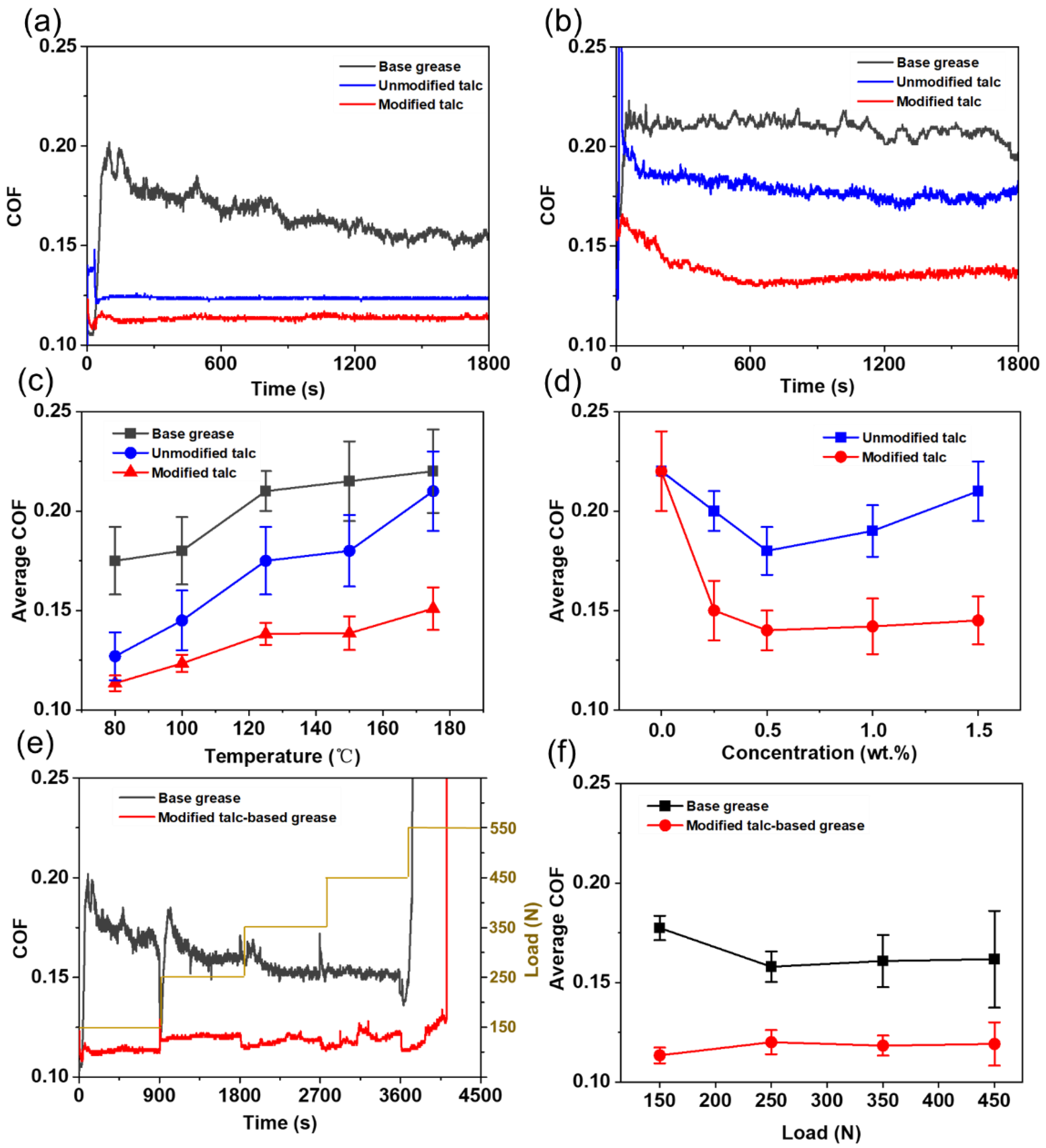
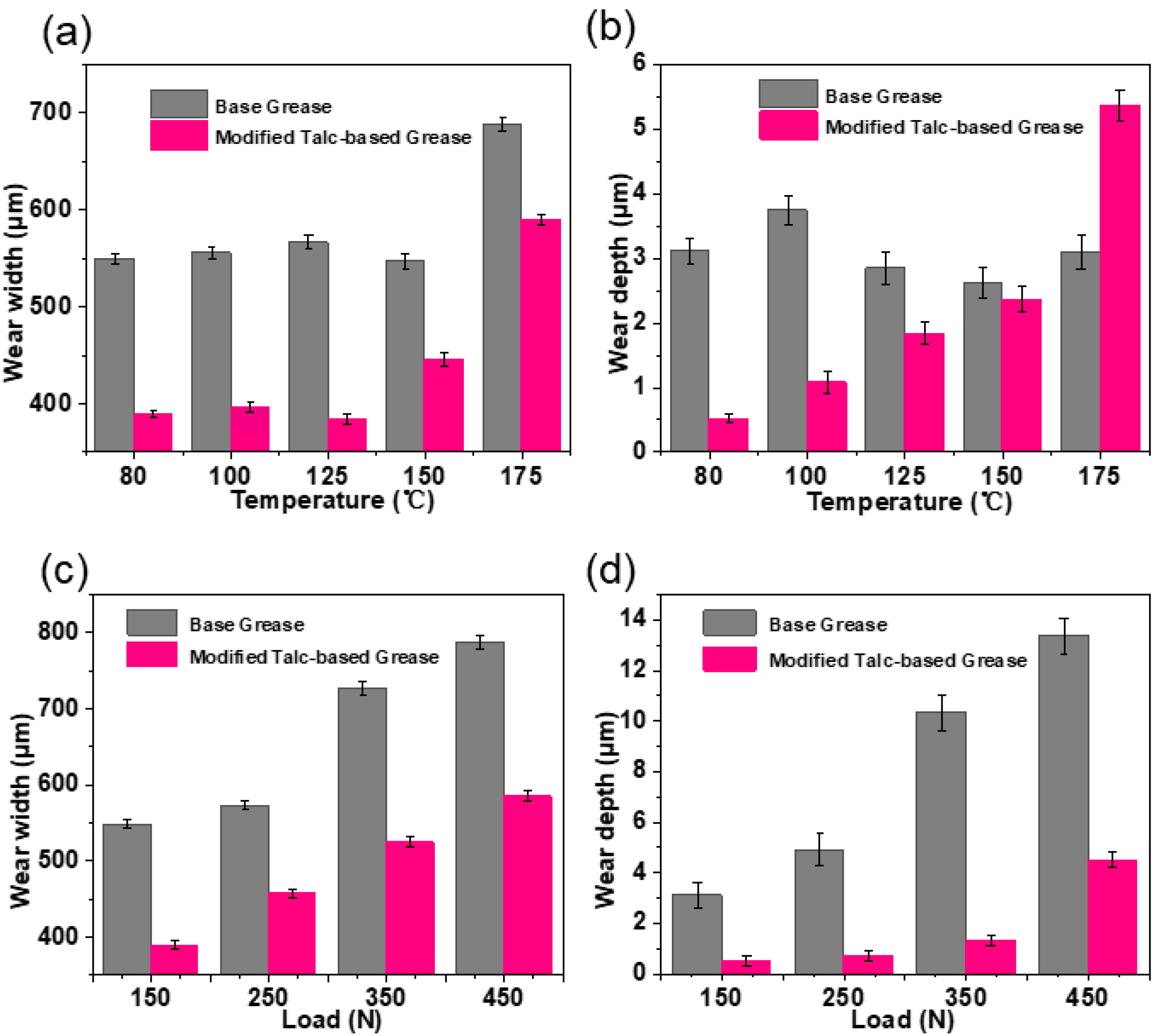


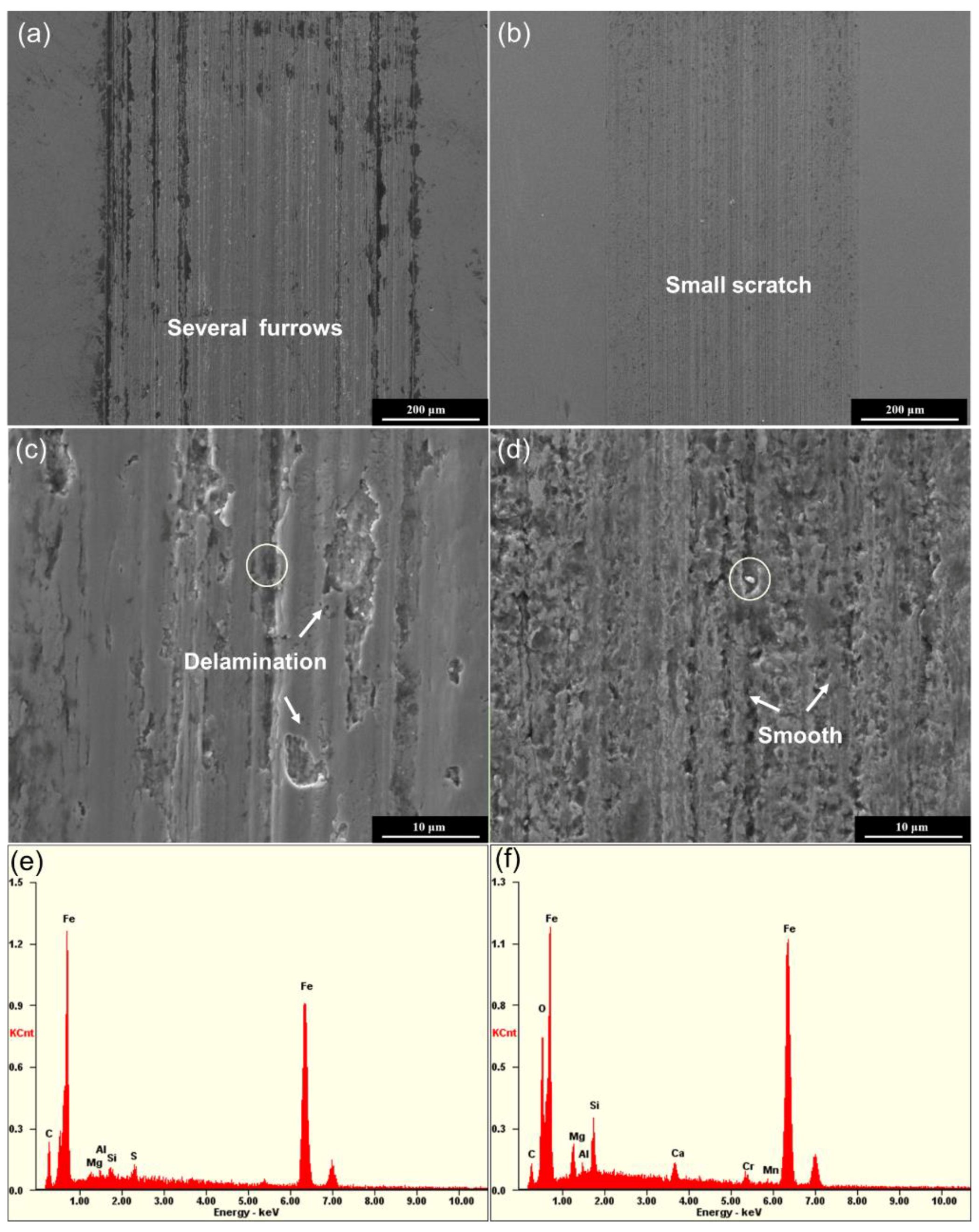
| Experimental Conditions | Parameter |
|---|---|
| Temperature | 80–175 °C |
| Normal load | 150–550 N (2.5–3.5 Gpa) |
| Sliding stroke | 2 mm |
| Frequency | 20 Hz |
| Sliding time | 30 min |
| Relative humidity | 50% |
| Test number | 3 |
Publisher’s Note: MDPI stays neutral with regard to jurisdictional claims in published maps and institutional affiliations. |
© 2022 by the authors. Licensee MDPI, Basel, Switzerland. This article is an open access article distributed under the terms and conditions of the Creative Commons Attribution (CC BY) license (https://creativecommons.org/licenses/by/4.0/).
Share and Cite
Zhao, J.; Gao, T.; Dang, J.; Cao, W.; Wang, Z.; Li, S.; Shi, Y. Using Green, Economical, Efficient Two-Dimensional (2D) Talc Nanosheets as Lubricant Additives under Harsh Conditions. Nanomaterials 2022, 12, 1666. https://doi.org/10.3390/nano12101666
Zhao J, Gao T, Dang J, Cao W, Wang Z, Li S, Shi Y. Using Green, Economical, Efficient Two-Dimensional (2D) Talc Nanosheets as Lubricant Additives under Harsh Conditions. Nanomaterials. 2022; 12(10):1666. https://doi.org/10.3390/nano12101666
Chicago/Turabian StyleZhao, Jun, Tong Gao, Jie Dang, Weiyu Cao, Ziqi Wang, Shuangxi Li, and Yijun Shi. 2022. "Using Green, Economical, Efficient Two-Dimensional (2D) Talc Nanosheets as Lubricant Additives under Harsh Conditions" Nanomaterials 12, no. 10: 1666. https://doi.org/10.3390/nano12101666
APA StyleZhao, J., Gao, T., Dang, J., Cao, W., Wang, Z., Li, S., & Shi, Y. (2022). Using Green, Economical, Efficient Two-Dimensional (2D) Talc Nanosheets as Lubricant Additives under Harsh Conditions. Nanomaterials, 12(10), 1666. https://doi.org/10.3390/nano12101666








